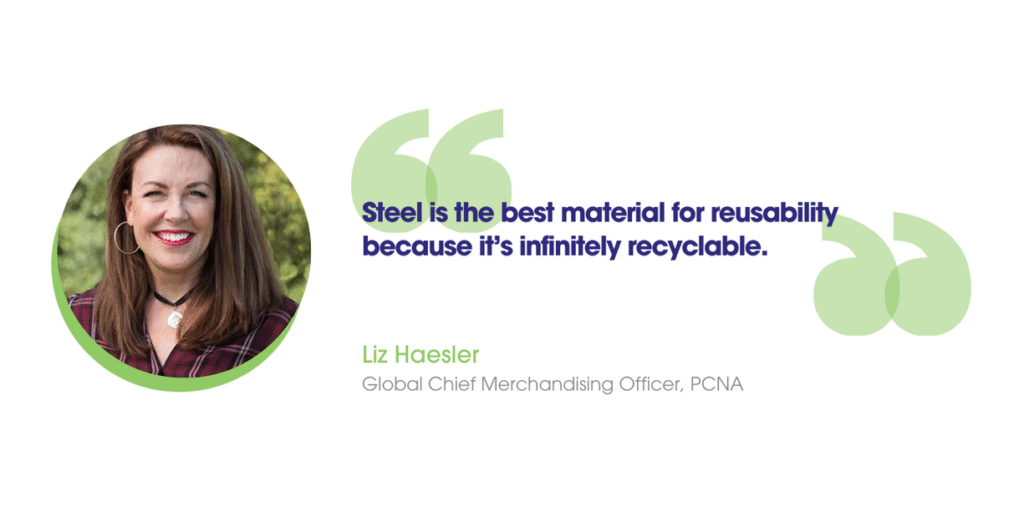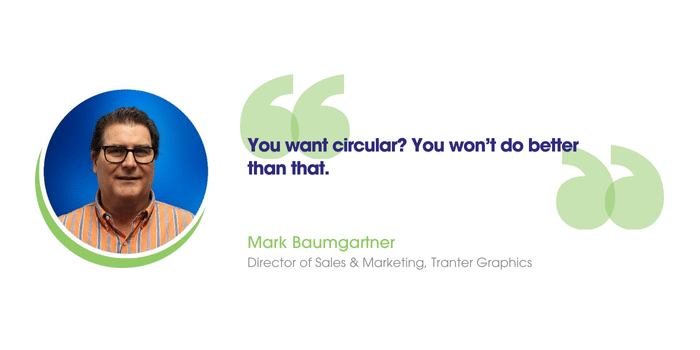Products made with recyclable materials are not necessarily the final frontier in sustainability. Really, they are something of a prerequisite for what is possible: circularity. In other words, keeping everything in an ongoing loop; products that are reused and materials that are recycled, avoiding a landfill forever.
Forever is a long time, but there is a material that can meet the task: steel.
“Steel is the best material for reusability because it’s infinitely recyclable,” says Liz Haesler, global chief merchandising officer at PCNA, which ranked No. 3 in PPAI 100’s list of suppliers, with high marks in Responsibility.
Now, large-scale event venues are beginning to see the feasibility and practicality of programs that incorporate reusable drinkware into their offerings, creating a potential trickle-down effect that not only has immediate sustainability benefits, but also normalizes the expectation that beverages come in reusable containers.
- Pepsi partnered with the Champions League Finals to offer reusable containers for the soccer matches.
- Coca-Cola ran a pilot program in Los Angeles’ Crypto.com Arena with reusable cups, reporting a 98% return rate for using those cups.
- The NBA’s Portland Trailblazers ran a similar program in the suite level seats that broadened to its 25,000-seat arena.
Reusable drinkware – steel and otherwise – has enormous potential for branding, as it can either reach multiple end users or remain with one end user over extended periods of time and through multiple uses. With the World Cup approaching in 2026, a theoretical reuse program for drinkware would set a new standard for venue operations.

A Rocky Journey For Sustainability
Promo firms looking to increase their sustainability options have the advantage of beginning on a road already paved by the suppliers that learned the hard way.
Mark Baumgartner, director of sales and marketing for Tranter Graphics, which ranked No. 57 on PPAI 100’s supplier list, has been putting efforts towards recycled materials for 35 years. He will be the first to note when sustainable products aren’t feasible, don’t sell or aren’t even as reusable as they are advertised, but that hasn’t stopped him from continuing to try to offer products that avoid landfill.
Paper, for example, has long been seen as a recyclable product, but for years, limiting the post-consumer waste of paper was a difficult and expensive process. De-inking paper had a high cost and required toxic chemicals, according to Baumgartner.
When it comes to promotional products, Baumgartner does not pretend that Tranter Graphics is a fully circular or sustainable operation.
“Our company prints customizable, single-use food and beverageware for many distributors, and we print a lot of it,” Baumgartner says. “The company success story started with these items 45 years ago, and it has been our flagship product lineup.”
- It’s likely unreasonable for any supplier to abandon what their business was originally built on in order to become more sustainable. Rather, it’s more realistic that they continue to invest in sustainable materials on the margins, meeting the growing demand while learning how to find scalable success in reusable products.
“In Q3 of 2024, Goldstar committed to having 57% of products that are recyclable, reusable or compostable,” says Lane Hockanson, global marketing manager at Goldstar.
That 57% is a feat for PPAI 100’s No. 16 supplier, but it is also a sign that it’s a process that can only become easier once you’ve started.
Ultimately, recycling methods have been far from perfect for years.
“Too many recycling operators have gone to single-source recycling,” says Baumgartner. “The bin takes all content from paper, steel, plastic and glass just to name a few. Imagine the cross contamination on all of these materials. It must be sorted and that is expensive. Paper absorbs most any liquid so if there is solvent, oil or other drippings, it is deemed unusable and goes to the landfill.
We have serious recycling issues, and we are going to need to do our part in manufacturing every step of the way.”
Tranter Graphics has added numerous recyclable products over the past few years, but the potentially scalable and legitimately effective option seems to be re-usable items, specifically, cups.
The Three-Tier System Of Steel Cups
Steel cups have existed for decades, but the market has only recently taken notice to the possibilities they create for sustainability. End-user and client expectations will always be met by willing suppliers.
“We observed a significant increase in demand for reusable steel cups last year,” Haesler says. “We did what we do best at PCNA: partnered with the best in the channel, Steel Chill Cups, to offer a branded opportunity in the recyclable steel cup space to meet this demand.”
In the case of Tranter Graphics, Baumgartner explains that there is a three-tiered pricing system in which recyclability, reusability and quality increase with each tier.
- The first tier offers paper cups.
- The second tier offers cups made from recyclable and sustainable materials that are compostable within months.
- The third tier is reusable steel (or plastic cups). This tier is infinitely recyclable.

“You want circular? You won’t do better than that,” Baumgartner says, adding that when the product was debuted in June, the supplier “blew through inventory” quickly.
Tranter Graphics refer to these type of “Stadium” cups as “souvenirable,” making them excellent options for large-scale venues to sell to attendees. Baumgartner says that when clients are asking for eco-friendly products, he asks them to consider the benefits of going the reusable route.
“There’s an argument for the branding power of a reusable cup that can be seen out in the open many times,” Baumgartner says. “And when the time comes, recycle it. The difference between the second-tier and the third-tier pricing is not that much depending on what re-usable item you’re going with.”
- Similarly, Goldstar currently has nine drinkware products that feature recycled stainless steel with flexible decoration methods and large imprint areas for custom branding.
As Haesler points out, PCNA sees steel cup offerings as a direct result of end user expectations.
“The bottom line is, people want to have a good time – whether that’s at a party, concert or sporting event – without negatively impacting our environment and sending more single-use items to our landfills,” Haesler says.
Having seen many attempts at sustainable products, Baumgartner sees steel cups as one of the truly effective methods in promotional products.
“Our future generations depend on us for keeping our planet, natural resources and a clean water supply available for them.”


